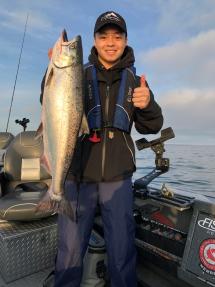ARCHIVED NEWS RELEASE
This document is provided for archival purposes only. Archived documents
do not reflect current WDFW regulations or policy and may contain factual
inaccuracies.
News release Aug. 11, 2022
Contact: Fish Program, 360-902-2700
Media contact: Mark Yuasa, 360-902-2262

OLYMPIA – East Elliott Bay will reopen for salmon fishing from Friday, Aug. 12 until noon on Monday, Aug. 15, after Washington Department of Fish and Wildlife (WDFW) fishery managers determined the Chinook return is large enough to support additional days of fishing.
“In coordination with tribal co-managers and the in-season tools that have been developed for this system, we’re able to have accurate updates for the East Elliott Bay area,” said Kirsten Simonsen, Ph.D., WDFW’s Puget Sound recreational salmon manager. “This allows us to provide more fishing opportunity within view of downtown Seattle.”
Fishing is allowed east of a line from Duwamish Head to Pier 91 up to the Duwamish River mouth, including Harbor Island (both the west and east Duwamish waterways). Salmon daily limit is 2. Chinook minimum size is 22”. Other salmon, no minimum size. Release Chum.
The East Elliott Bay recreational salmon fishery was open Aug. 5-7, and 322 boats with 673 anglers retained 125 Chinook and released 219 Chinook.
Click here to see the fishing rule changes. Puget Sound salmon seasons are a result of an annual collaborative state and tribal salmon season-setting process known as North of Falcon. The Puget Sound salmon fishery guidelines and quotas can be viewed here.
Several other marine areas are currently open for salmon fishing and can be found on the WDFW website. For additional information about this year's sport salmon fisheries and the North of Falcon salmon season setting process go to the WDFW website.
WDFW fishery managers continue to call on salmon anglers to submit voluntary Salmon Trip Reports to help to increase the amount of data available for in-season management. These trip reports are just one tool in a suite of options fisheries managers use to collect biological and fishery data for Puget Sound salmon. Other monitoring tools include dockside sampling, test fishing, and boat surveys. Anglers can complete the voluntary Salmon Trip Report Form online at https://str.wdfw-fish.us/home or visit the WDFW website at https://wdfw.wa.gov/licenses/fishing/trip-reporting to download a paper copy.
The Washington Department of Fish and Wildlife works to preserve, protect, and perpetuate fish, wildlife and ecosystems while providing sustainable fish and wildlife recreational and commercial opportunities.